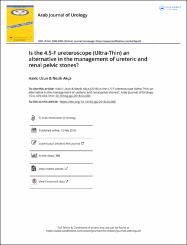| dc.contributor.author | Uzun, Hakkı | |
| dc.contributor.author | Akça, Nezih | |
| dc.date.accessioned | 2020-12-19T19:41:00Z | |
| dc.date.available | 2020-12-19T19:41:00Z | |
| dc.date.issued | 2018 | |
| dc.identifier.citation | Uzun, H., & Akça, N. (2018). Is the 4.5-F ureteroscope (Ultra-Thin) an alternative in the management of ureteric and renal pelvic stones?. Arab journal of urology, 16(4), 429–434. https://doi.org/10.1016/j.aju.2018.04.006 | en_US |
| dc.identifier.issn | 2090-598X | |
| dc.identifier.issn | 2090-5998 | |
| dc.identifier.uri | https://doi.org/10.1016/j.aju.2018.04.006 | |
| dc.identifier.uri | https://hdl.handle.net/11436/1706 | |
| dc.description | WOS: 000451771800010 | en_US |
| dc.description | PubMed: 30534443 | en_US |
| dc.description.abstract | Objectives: To compare the 7.5-9.5F ureteroscope (URS) with the 4.5-6.5F URS (Ultra-Thin) in terms of success and complication rates in adult patients with ureteric and renal pelvic stones. Patients and methods: in all, 41 patients treated with 7.5-9.5F semi-rigid URS (Group 1) and 33 patients treated with the Ultra-Thin (Group 2) were prospectively included in the study. All patients underwent holmium laser ureteroscopic lithotripsy. in each group, when the selected ureteroscopic intervention failed to reach or disintegrate the stone, the URS was replaced with the other one. Outcome criteria were: success and complication rates, stone size and stone surface area, operative time, laser time, usage of guidewire, and postoperative JJ-catheter placement. Results: the ureteroscopic lithotripsy in 36 of 41 (87.8%) and 24 of 33 (72.7%) patients was completed without a need to replace the URS with the other one in groups 1 and 2, respectively (P = 0.67). After replacement of the 7.5-9.5F URS with the Ultra-Thin for patients who failed in Group 1, the overall stone-free rate (SFR) improved to 97.5% (P = 0.014). in Group 2, after replacement of the Ultra-Thin with the 7.5-9.5F URS for the failed patients, the overall SFR improved to 96.9% (P = 0.02). There was no significant difference between the groups for complications. Postoperative JJ stenting was significantly less in Group 2 (21.2%) in comparison to Group 1 (46.3%) (P = 0.02). Conclusions: the Ultra-Thin has a similar success rate as the 7.5-9.5F URS in the treatment of ureteric stones and is a feasible option in patients in whom a conventional URS cannot be advanced through any segment of the ureter. (C) 2018 Production and hosting by Elsevier B.V. on behalf of Arab Association of Urology. | en_US |
| dc.language.iso | eng | en_US |
| dc.publisher | Arab Assoc Urology | en_US |
| dc.rights | info:eu-repo/semantics/openAccess | en_US |
| dc.subject | Ultra-Thin | en_US |
| dc.subject | Lithotripsy | en_US |
| dc.subject | Ureteroscopy | en_US |
| dc.title | Is the 4.5-F ureteroscope (Ultra-Thin) an alternative in the management of ureteric and renal pelvic stones? | en_US |
| dc.type | article | en_US |
| dc.contributor.department | RTEÜ, Tıp Fakültesi, Cerrahi Tıp Bilimleri Bölümü | en_US |
| dc.contributor.institutionauthor | Uzun, Hakkı | |
| dc.contributor.institutionauthor | Akça, Nezih | |
| dc.identifier.doi | 10.1016/j.aju.2018.04.006 | |
| dc.identifier.volume | 16 | en_US |
| dc.identifier.issue | 4 | en_US |
| dc.identifier.startpage | 429 | en_US |
| dc.identifier.endpage | 434 | en_US |
| dc.ri.edit | oa | en_US |
| dc.relation.journal | Arab Journal of Urology | en_US |
| dc.relation.publicationcategory | Makale - Uluslararası Hakemli Dergi - Kurum Öğretim Elemanı | en_US |


















